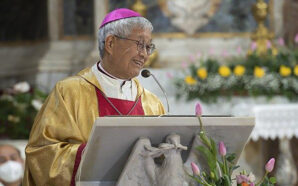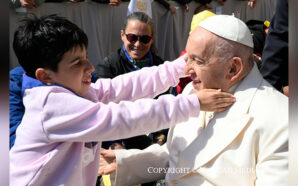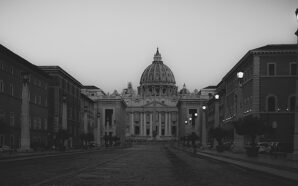Homily for the Sixteenth Sunday in Ordinary Time, Year C
Readings: Genesis 18:1-10a; Psalm 15; Colossians 1:24-28; Luke 10:38-42
17 July 2022
Many twenty-first-century women flinch a little when they hear today’s readings. In the first reading from Genesis, the three strangers come upon Abraham who offers them hospitality. ‘Abraham hastened into the tent and told Sarah, “Quick, three measures of fine flour! Knead it and make rolls.”’ When the meal is ready, Abraham serves the strangers and Sarah remains out of sight – out of sight and out of mind, one might say. In the gospel, the sisters Martha and Mary entertain the visitor Jesus. Martha labours in the background while Mary sits adoringly and listens to Jesus’ every word. There is more than a touch of submissiveness in the actions of both sisters, and one senses that such submission would have been shown to any male visitor and not just Jesus. One woman friend commented to me, ‘None of you men have ever had the courage to say that of course Jesus expected to be waited on.’ He was, of course, a first-century Jew, and not a twenty-first-century new-age guy.
Listen at https://soundcloud.com/frank-brennan-6/homily-17722
Regardless of gender, every Christian is called to display something of Martha and of Mary. We are called to be contemplatives in action. There are cultural sensitivities now common to us which were unknown in the times of Jesus and Abraham. Those sensitivities continue to clash with some of our traditional ways of doing things and seeing things in our Church as well as in society. It’s by being attentive to those sensitivities that we can be attentive to the action of the Spirit.
The 277 members of the Plenary Council of our Church have now returned to their home dioceses amidst diverse reports about what happened the previous week in Sydney. The neuralgic point, or the moment of the Spirit’s disruption, came with the consideration of the motions on the equal dignity of men and women. Peter Comensoli, the Archbishop of Melbourne, has written to us all saying: ‘It should be remembered that what happens within the confines of a gathering of this kind is not necessarily what is spoken of outside of the gathering.’[1] He goes on to ask, ‘So, what did happen?’ This has been the question on the lips of many Catholics who did not have the good fortune to be in the room. I was looking forward to the Archbishop’s account of what did happen. There can of course be no authorised episcopal version of what happened, but like any of us, he could give us his considered opinion and accurate observations. Archbishop Comensoli makes no attempt to provide an answer to his question other than to provide these words of encouragement: ‘Might I encourage you to read and reflect on two documents. Firstly, there are the Decrees that set out all the motions that were passed with a two-third’s majority[2]. …This is the work that we now take forward in the life of our local Church, the fruits of these past several years and a pathway for the years to come. Secondly, please see the final summary statement from the Assembly of what occurred during the week. This is a document that those present agreed to as a final summation of the Assembly.[3] … These two documents, as distinct from anything else you may have heard about, contain the fruits of the second and final Assembly of the Fifth Plenary Council of the Catholic Church in Australia.’ These documents may contain the fruits or formal outcomes; but they don’t tell us what happened.
Fortunately for those who do want to know what happened, a number of other Plenary Council members including Archbishops Mark Coleridge and Anthony Fisher, Sisters Patty Fawkner and Melissa Dwyer, Professor John Warhurst and Mr Francis Sullivan have given fairly direct accounts of what, in their opinion, did happen on the floor of the Assembly. While the mainstream secular media was keen to play up the controversy, there were other media commentators of great experience and professional competence who took soundings from many Plenary Council members before providing accurate summaries of what happened.
On Monday evening, we were privileged to hear from one of those commentators, Christopher Lamb, the Vatican correspondent for the London Tablet. He was in Sydney for the Plenary Council meeting and spoke to a broad range of participating members including Archbishops Coleridge and Fisher, the president and vice president of the Australian Catholic Bishops Conference. Christopher Lamb came to Newman College and delivered the annual Helder Camara Lecture on ‘The Outsider Pope: Where is Francis leading our Church?’ [4]
Lamb has a keen sense of the tension playing out during the Francis papacy and provided this as a backdrop to understanding what was happening on the floor of the Plenary. He told us: ‘My thesis about the opposition is as follows: at its heart, the Francis pontificate is an attempt to implement a Gospel-based reform of the Church by applying the essentials of the Christian faith. It is rooted in a deep trust in the action of the Holy Spirit to update and renew the Church, including its structures.’ He was adamant that ‘Francis is not a conservative or a liberal. He is a radical who always places the emphasis on the lived practice of faith while resisting all attempts to place ideological labels on the Church.’
Lamb saw something of this tension playing out on the floor of the Sydney Plenary. He observed:
‘When a moment of crisis came, and the vote on the role of women in the Church failed to receive a majority, the bishops were forced to stop and listen to the cry of the people in the room. The bishops could have ploughed on. But this was an example of a Church seeking to overcome the mentality of clericalism, the disconnect between the leadership of the Church and those whom they are called to serve. After crisis talks, a series of re-worked motions on the role of women were passed which seek to make this collaborative form of decision making a reality.’
This is part – a critical part – of what happened at the Plenary. Some like Archbishop Comensoli will be satisfied that the two final documents provide all we need to know satisfying our curiosity about what happened at the Plenary. There will be others of us who discern the action of the Spirit and identify something significant happening by unpacking what occurred when the 60 women and their supporters took their stand and when a significant number of bishops changed their votes.
Even those of us who think the two final documents all too modest can take heart with the observation by Lamb: ‘The Church in Australia deserves some credit for taking a leap into the dark and embarking on this council in its attempt to build a Church that is fit for purpose, and alive to the work of the Holy Spirit today. This is what Francis is seeking from the entire Church as it becomes more synodal.’
Lamb is right to observe that ‘trusting also means being ready for the messiness of synodality. We saw this in Sydney when the votes on women failed and a number of members made their feelings known in the hall. This clearly shocked the bishops. There was high emotion. People were in tears. A slew of negative media stories ensued. Nevertheless, these fights have to take place and unless the crisis is embraced you don’t get renewal.’
Lamb says, ‘The ability to hold different views in tension, and then find consensus, was a strength of the Plenary Council and it is something Francis wants to see across the Church. It means that synodal Church stands as a counter-culture witness to a culture which continuously demands people to make “either/or” choices on political or other contested issues, and then separates them into camps.’
Archbishop Comensoli rightly claims that ‘the Assembly was not like a sitting week of the Australian Parliament’. But it was still a deliberative body that considered the conflicting arguments put forward before members discerned what the Spirit was asking of them. Let us not make the mistake in our meetings of using spiritual discernment as a foil for our failing to ask the right questions or for failing to provide transparent and complete answers. Discernment comes into play when we have all the facts to hand.
Inspired by the action of the Spirit at the Plenary, each of us can recommit ourselves as contemplatives in action being committed to providing the wherewithal so that the stranger might be fed and to being attentive to the Risen Lord in our midst. May the example of Sarah, Martha and Mary inspire us to serve others and proclaim the equal dignity of all.
R.(1a) Those who do justice will live in the presence of the Lord.
One who walks blamelessly and does justice;
who thinks the truth in her heart
and slanders not with her tongue.
R. Those who do justice will live in the presence of the Lord.
Who harms not his fellow man,
nor takes up a reproach against his neighbour;
by whom the reprobate is despised,
while he honours those who fear the LORD.
R. Those who do justice will live in the presence of the Lord.
[1] Archbishop Peter Comensoli, Letter ‘To all of Christ’s Faithful in the Archdiocese of Melbourne’ 15 July 2022 available at https://melbournecatholic.org/news/archbishops-letter-to-the-faithful-reflects-on-the-plenary-council
[2] See www.bit.ly/PlenaryCouncilDecrees
[3] See www.bit.ly/PlenaryCouncilSummary
[4] Christopher Lamb, ‘The Outsider Pope: Where is Francis leading our Church?’, 11 July 2022, available at https://newman.unimelb.edu.au/uploads/helder-camara-lectures/HelderCamaraLecture-NewmanJuly2022.pdf
Fr Frank Brennan SJ is the Rector of Newman College, Melbourne, and the former CEO of Catholic Social Services Australia (CSSA). He was appointed a peritus at the Fifth Plenary Council of the Australian Catholic Church.








